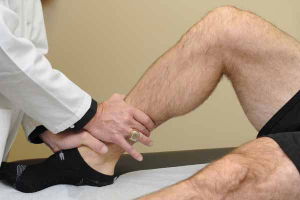The quadriceps active test basically starts at the initial position of the tibial drop back sign. In a patient with an intact PCL, when one fires their quadriceps mechanism at 90° of knee flexion, the knee should not move forward noticeably. In patients who have a PCL tear, when the quadriceps mechanism fires, it pulls through the patella, patellar tendon, and ultimately on the tibial tubercle to pull the tibia back to a reduced position. This is the principle behind the quadriceps active test. This test is most useful when there may be a subtle PCL tear or if one is trying to determine on exam between a partial PCL tear or solely an ACL tear.
The quadriceps active test is performed with the knee flexed between 80°-90° and in neutral rotation. From this initial position, the patient is then asked to fire the quadriceps muscle while the examiner applies counter pressure against the ankle. As the quadriceps applies pressure through the patella and patellar tendon to pull the tibial tubercle anteriorly, any posterior translation of the tibia on the femur will be reduced back to a normal position.

